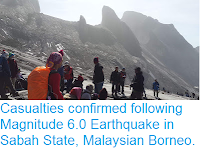A family of eleven has been made homeless following a landslide which destroyed their home on Thursday 23 November 2017. The incident happened slightly after 2.15 am local time, at Jalan Melekun in the Kapit Division, and also damaged three other properties, though fortunately nobody was hurt as the family were away at the time. The incident is reported to have happened after heavy rainfall in the area.
The scene of the 23 November 2017 Kapit landslide. The Star.
The incident is reported to have happened after heavy rainfall in the area. Landslides are a common problem after severe weather
events,
as excess pore water pressure can overcome cohesion in soil and
sediments, allowing them to flow like liquids. Malaysia has become
increasingly landslip-prone in recent years due to
extensive deforestation, which leaves soil exposed to heavy tropical
rainfall. Concerns have also been raised about the large number of
construction sites on steep hillslopes in urban areas, where workers are
particularly vulnerable to landslip events during the Monsoon Seasons.
The approximate location of the 23 November 2017 Kapit landslide. Google Maps.
Sarawak has two distinct Monsoon Seasons, with a Northeast Monsoon driven
by winds from the South China Sea that lasts from November to February
and a Southwest Monsoon driven by winds from the southern Indian Ocean from March to October. Such a double Monsoon Season is common
close
to the equator, where the Sun is highest overhead around the equinoxes
and lowest on the horizons around the solstices, making the solstices
the coolest part of the year and the equinoxes the hottest.
The winds that drive the Northeast and Southwest Monsoons in Southeast Asia. Mynewshub.
Monsoons
are tropical sea breezes triggered by heating of the land during the
warmer part of the year (summer). Both the land and sea are warmed by
the Sun, but the land has a lower ability to absorb heat, radiating it
back so that the air above landmasses becomes significantly warmer than
that over the sea, causing the air above the land to rise and drawing in
water from over the sea; since this has also been warmed it carries a
high evaporated water content, and brings with it heavy rainfall. In the
tropical dry season the situation is reversed, as the air over the land
cools more rapidly with the seasons, leading to warmer air over the
sea, and thus breezes moving from the shore to the sea (where air is
rising more rapidly) and a drying of the climate.
Diagrammatic representation of wind and rainfall patterns in a tropical monsoon climate. Geosciences/University of Arizona.
See also...
Follow Sciency Thoughts on Facebook.










